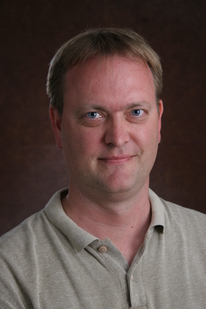
Flow dynamics work promises fuel efficiency, less pollution
Posted: April 12, 2011
Advances in use of liquids and gases for medical, environmental and energy-efficiency improvements earn support for ASU researcher from National Science Foundation
Marcus Herrmann is a kind of expert mixologist – but one who specializes in things that don’t mix well, like oil and water.
The Arizona State University mechanical engineer is helping make strides in understanding the flow dynamics of immiscible interfaces – in other words, how gases and liquids that don’t combine well can be expected to behave when they must be used together to spark various mechanical and chemical processes.
Predicting and controlling that behavior is critical to systems that require the characteristics of both gases and liquids for energy-conversion processes for technologies such as the standard combustion engine in most of the world’s motor vehicles.
Better prediction and control of such processes are the keys to advances toward the next generations of fuel and energy-conversion technologies, including fuel-injection systems, as well as medical sprays and environmental protection and management methods.
Herrmann’s progress in this area has earned him a National Science Foundation CAREER Award. It’s given to engineers and scientists considered potential leaders in research and teaching in fields vital to national interests.
More than 20 ASU engineering faculty members have received CAREER awards in the past five years.
This latest CAREER award comes with a grant of about $400,000 over five years to fund research led by Herrmann, an assistant professor in the School for Engineering of Matter, Transport and Energy, one of ASU’s Ira A. Fulton Schools of Engineering.
He’ll work with ASU colleagues and lead a team of graduate students in developing better computational tools and methods for simulating the flows of immiscible gases and liquids under various environmental and operational conditions.
Progress in that endeavor can play a pivotal role in making significant improvements in engine performance, fuel efficiency, reducing pollution from combustion engines, and development of alternative energy sources that would decrease the nation’s dependency on fossil fuels.
Beyond those areas, Herrmann says, improved computation and simulation tools would enable more effective containment and cleanup of such things as oil and petroleum spills in oceans – such as last year’s large spill in the Gulf of Mexico.
“Our work could help provide tools to analyze the performance of oil-spill containment options,” he says. “This could help cut down on the trial-and-error approaches that are often used. It would provide a guide to how different containment strategies would work in various oil-spill scenarios.”
Herrmann “is at the forefront of work in devising models to predict the behavior of immisicible interfaces,” says Kyle Squires, director of the School for Engineering of Matter, Transport and Energy. “With support from his CAREER Award he’ll be able to make progress toward a real breakthrough in prediction of the entire atomization process in a complex, next-generation gas turbine fuel injector under realistic operating conditions.”
More fully understanding how gases and liquids atomize – or break up into spray drops – is essential to designing better fuel injectors that will provide more fuel efficiency and reduce production of pollutants.
More knowledge about the physics that guide the behavior of unmixable gases and liquids used in combination could also improve the efficiency of medical sprays (think nasal sprays, for example).
With such information, devices used to apply a spray could be designed with the precise geometric structure necessary to produce the optimal balance of air and liquid drops to make the medicine work most effectively.
Herrmann says advanced fluid dynamics computations also might help us better predict the potential eruptions and behaviors of tsunamis, and more deeply understand the carbon dioxide exchange process between the Earth’s atmosphere and oceans, which would benefit climate studies and forecasts.
The CAREER Award grant will also help support an educational outreach project that will bring engineering instruction – through a program to be called “Fun with Flows” – to an elementary school in Scottsdale and later to other schools throughout Arizona.
In addition, the grant will enable Herrmann to give a number of ASU undergraduate students opportunities to participate in his research projects.
Herrmann will bring findings gained from his research into classes he teaches on combustion, computational fluid dynamics, numerical methods and linear algebra in engineering.
Herrmann came to ASU in 2007 after working as a research associate at Stanford University. Earlier he was a visiting scientist at Technical University Eindhoven in the Netherlands and a researcher at the Technical University Aachen
Institut für Technische Mechanik in Germany, where earned a doctoral degree in mechanical engineering.
He earned scholarships and fellowships from several prominent university engineering and science programs in Europe. Most recently, Herrmann won the 2010 Best Video award from the American Physical Society’s Division of Fluid Dynamics Gallery of Fluid Motion.




































